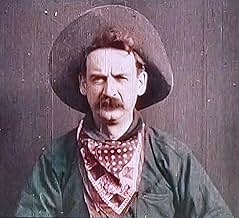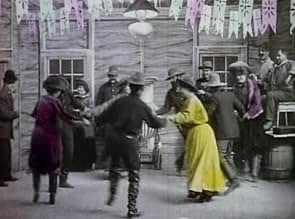A group of bandits stage a brazen train hold-up, only to find a determined posse hot on their heels.A group of bandits stage a brazen train hold-up, only to find a determined posse hot on their heels.A group of bandits stage a brazen train hold-up, only to find a determined posse hot on their heels.
- Director
- Writers
- Stars
- Awards
- 1 win total
Gilbert M. 'Broncho Billy' Anderson
- Bandit
- (uncredited)
- …
A.C. Abadie
- Sheriff
- (uncredited)
Justus D. Barnes
- Bandit Who Fires at Camera
- (uncredited)
Walter Cameron
- Sheriff
- (uncredited)
John Manus Dougherty Sr.
- Fourth Bandit
- (uncredited)
Donald Gallaher
- Little Boy
- (uncredited)
Shadrack E. Graham
- Child
- (uncredited)
Frank Hanaway
- Bandit
- (uncredited)
Adam Charles Hayman
- Bandit
- (uncredited)
Robert Milasch
- Trainman
- (uncredited)
- …
Marie Murray
- Dance-Hall Dancer
- (uncredited)
Frederick T. Scott
- Man
- (uncredited)
Mary Snow
- Little Girl
- (uncredited)
- Director
- Writers
- All cast & crew
- Production, box office & more at IMDbPro
Featured reviews
The wild west. Tales of daring do on horse back. Such images conjured up by the term "wild west" conjure images of cowboys making peace with indians, train robberys, buffalo hunts and the indian wars. This term also conjures up law and order which, in that era a live by the sword and die by it venture. THE GREAT TRAIN ROBBERY captures the brutal lawless stories of the old west and translates it to film. Literally the film that started it all, this film proved story telling had moved from cave wall drawings, to pen and paper, and now celluloid. A great film for the era in which it was made and today as a historical heirloom. The GREAT TRAIN ROBBERY helped permanently capture the imagination of audiences everywhere.
This film, often lauded as one of the first movies to include a linear narrative within its running time, came out of the Edison company over a hundred years ago, following their experiments in the previous decades with shorter topical pieces such as cockfighting, dancers, and other limited scenarios.
'The Great Train Robbery' is a simple enough story - a train is robbed, there is a shoot-out. The interesting scenes for me were the ones where the passengers are held at gunpoint while their valuables are collected, the shoot-out with its hand-coloured bursts of gunfire, and the famous final shot where a gun is fired directly at the audience. Not too frightening now, but back in those days this was quite an innovation.
Historically important and with a basic plot still in use today, this film holds significant interest for a wide audience (and will take less than a quarter of an hour of your time to view).
'The Great Train Robbery' is a simple enough story - a train is robbed, there is a shoot-out. The interesting scenes for me were the ones where the passengers are held at gunpoint while their valuables are collected, the shoot-out with its hand-coloured bursts of gunfire, and the famous final shot where a gun is fired directly at the audience. Not too frightening now, but back in those days this was quite an innovation.
Historically important and with a basic plot still in use today, this film holds significant interest for a wide audience (and will take less than a quarter of an hour of your time to view).
It's easy to see why this was such a sensation in 1903, and why today it is still considered to be an icon in movie history. You can enjoy this either as a historical landmark for its use of such a variety of then-new skills, or you can simply watch it for the story. To be sure, the plot is of a now-familiar type, but this is what so many other movies have imitated over the years.
The story-telling is very good, and it is almost not even necessary to add 'for its time', because much of it still holds up quite well. It tells an action-packed story with plenty of detail, and it uses a good variety of effective techniques to increase the excitement, suspense, and realism. From the motion effects in the scenes inside the train, to the occasional use of color tinting, to the use of outdoor scenes, almost everything works nicely. There are only a few occasions when can you tell that it is almost a century old. There are even things like some basic cross-cutting and a pretty good panning shot. There is plenty to see, and it's worth watching more than once to see what else you can notice.
The story-telling is very good, and it is almost not even necessary to add 'for its time', because much of it still holds up quite well. It tells an action-packed story with plenty of detail, and it uses a good variety of effective techniques to increase the excitement, suspense, and realism. From the motion effects in the scenes inside the train, to the occasional use of color tinting, to the use of outdoor scenes, almost everything works nicely. There are only a few occasions when can you tell that it is almost a century old. There are even things like some basic cross-cutting and a pretty good panning shot. There is plenty to see, and it's worth watching more than once to see what else you can notice.
It's hard to assign "The Great Train Robbery" a rating, as it shouldn't really be watched as a film the way we watch films now. But from a historical perspective, it's fascinating, and is an excellent example of the use of film editing, an art form then in its infancy and now an award category recognized every year at the Oscars.
Before this movie, it wasn't customary to tell multiple story lines simultaneously, but here, various activities going on in different locations are intercut to create suspense. D.W. Griffith would use this technique much more ambitiously (and combine it with many other developing film techniques) in "The Birth of a Nation" over ten years later, but credit must be given to "Train Robbery" for blazing a trail.
Also, this is the movie famous for the shot of an outlaw shooting a gun directly at the camera. I can't imagine what effect this had on audiences at the time, who were probably diving behind their chairs for cover.
Grade: A
Before this movie, it wasn't customary to tell multiple story lines simultaneously, but here, various activities going on in different locations are intercut to create suspense. D.W. Griffith would use this technique much more ambitiously (and combine it with many other developing film techniques) in "The Birth of a Nation" over ten years later, but credit must be given to "Train Robbery" for blazing a trail.
Also, this is the movie famous for the shot of an outlaw shooting a gun directly at the camera. I can't imagine what effect this had on audiences at the time, who were probably diving behind their chairs for cover.
Grade: A
I enjoy this film even though it is very old and compared to today's cinema, very limited in its attempt at realism. But today's cinema would not be what it is without the original innovation of cinematic devices by Edwin S. Porter, one of films first masters. His progress in narrative construction and his work in special effects techniques astonished audiences like never before. His work was limited specifically because he used the static camera affecting the impact of each of his shots. His unique and influential editing style allowed the audience to take part in the action of the film, not sitting idly watching it. The movie is 12 minutes long and is considered the first narrative film in history. The most exciting scene is when the gangsters raid the train station and rob the train. The train is a really well done mat-shot of a train pulling into the station, frightening the audience in their seats. I personally am most excited by the final closing scene of the gangster shooting his gun, aiming it directly at the audience. This audience point of view shot makes me feel like the narrative of the train robbery enticed me to cheer for the Sheriff, and the angry gangster shoots at me because I was cheering for his enemy. This film and this sequence of the gangster shooting the audience was solidified in cinematic history when Martin Scorsese pays homage in 'Goodfellas', with Joe Pesci gun barrage and sinister look.
Storyline
Did you know
- TriviaThe original camera negative still exists in excellent condition. The Library of Congress, who holds it, can still make new prints.
- GoofsWhen the telegraph operator revives with his hands tied behind his back, he uses one of his hands to help him stand up and then quickly puts the hand behind his back again.
- Alternate versionsThere is an Italian edition of this film on DVD, distributed by DNA srl, "CENTRO! (Straight Shooting, 1917) + IL CAVALLO D'ACCIAIO (The Iron Horse, 1924) + LA GRANDE RAPINA AL TRENO (The Great Train Robbery, 1903)" (3 Films on a single DVD), re-edited with the contribution of film historian Riccardo Cusin. This version is also available for streaming on some platforms.
- ConnectionsEdited into Hollywood: The Dream Factory (1972)
Details
- Release date
- Country of origin
- Language
- Also known as
- Велике пограбування потягу
- Filming locations
- Production company
- See more company credits at IMDbPro
Box office
- Budget
- $150 (estimated)
- Runtime11 minutes
- Sound mix
- Aspect ratio
- 1.33 : 1
Contribute to this page
Suggest an edit or add missing content

Top Gap
By what name was The Great Train Robbery (1903) officially released in India in English?
Answer























